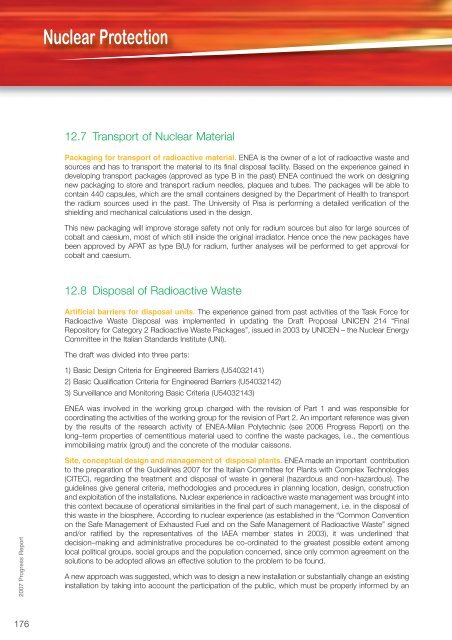Fusion Programme - ENEA - Fusione
Fusion Programme - ENEA - Fusione
Fusion Programme - ENEA - Fusione
- No tags were found...
Create successful ePaper yourself
Turn your PDF publications into a flip-book with our unique Google optimized e-Paper software.
Nuclear Protection12.7 Transport of Nuclear MaterialPackaging for transport of radioactive material. <strong>ENEA</strong> is the owner of a lot of radioactive waste andsources and has to transport the material to its final disposal facility. Based on the experience gained indeveloping transport packages (approved as type B in the past) <strong>ENEA</strong> continued the work on designingnew packaging to store and transport radium needles, plaques and tubes. The packages will be able tocontain 440 capsules, which are the small containers designed by the Department of Health to transportthe radium sources used in the past. The University of Pisa is performing a detailed verification of theshielding and mechanical calculations used in the design.This new packaging will improve storage safety not only for radium sources but also for large sources ofcobalt and caesium, most of which still inside the original irradiator. Hence once the new packages havebeen approved by APAT as type B(U) for radium, further analyses will be performed to get approval forcobalt and caesium.12.8 Disposal of Radioactive WasteArtificial barriers for disposal units. The experience gained from past activities of the Task Force forRadioactive Waste Disposal was implemented in updating the Draft Proposal UNICEN 214 “FinalRepository for Category 2 Radioactive Waste Packages”, issued in 2003 by UNICEN – the Nuclear EnergyCommittee in the Italian Standards Institute (UNI).The draft was divided into three parts:1) Basic Design Criteria for Engineered Barriers (U54032141)2) Basic Qualification Criteria for Engineered Barriers (U54032142)3) Surveillance and Monitoring Basic Criteria (U54032143)<strong>ENEA</strong> was involved in the working group charged with the revision of Part 1 and was responsible forcoordinating the activities of the working group for the revision of Part 2. An important reference was givenby the results of the research activity of <strong>ENEA</strong>-Milan Polytechnic (see 2006 Progress Report) on thelong–term properties of cementitious material used to confine the waste packages, i.e., the cementiousimmobilising matrix (grout) and the concrete of the modular caissons.2007 Progress ReportSite, conceptual design and management of disposal plants. <strong>ENEA</strong> made an important contributionto the preparation of the Guidelines 2007 for the Italian Committee for Plants with Complex Technologies(CITEC), regarding the treatment and disposal of waste in general (hazardous and non-hazardous). Theguidelines give general criteria, methodologies and procedures in planning location, design, constructionand exploitation of the installations. Nuclear experience in radioactive waste management was brought intothis context because of operational similarities in the final part of such management, i.e. in the disposal ofthis waste in the biosphere. According to nuclear experience (as established in the “Common Conventionon the Safe Management of Exhausted Fuel and on the Safe Management of Radioactive Waste” signedand/or ratified by the representatives of the IAEA member states in 2003), it was underlined thatdecision–making and administrative procedures be co-ordinated to the greatest possible extent amonglocal political groups, social groups and the population concerned, since only common agreement on thesolutions to be adopted allows an effective solution to the problem to be found.A new approach was suggested, which was to design a new installation or substantially change an existinginstallation by taking into account the participation of the public, which must be properly informed by an176













